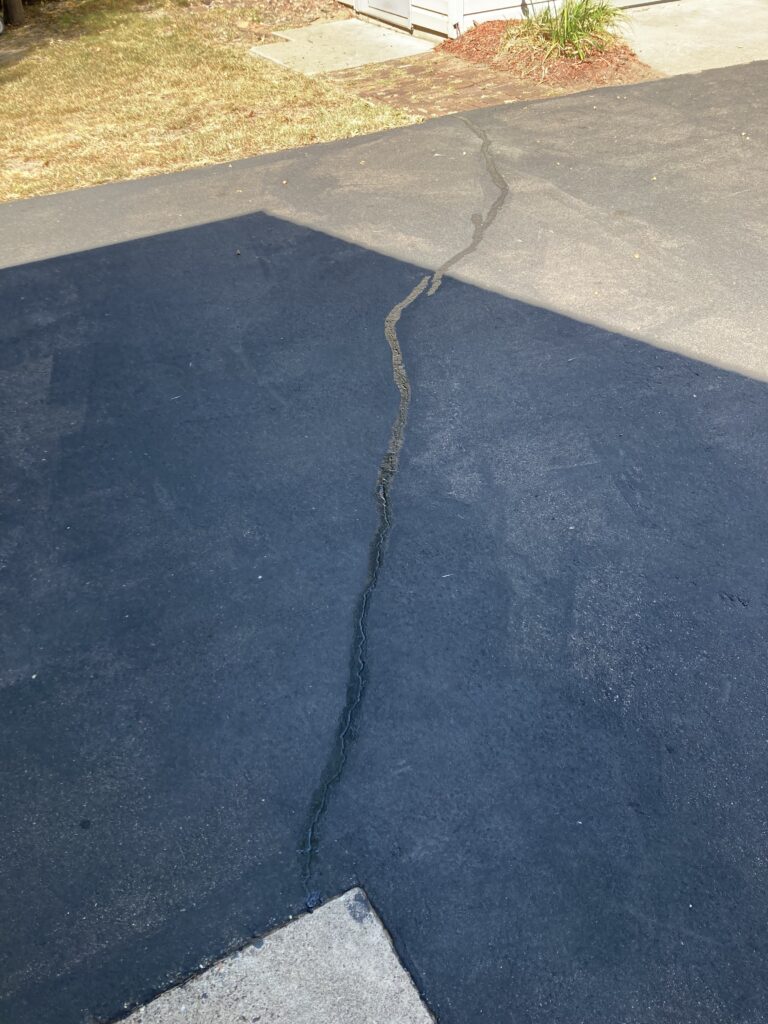One of my goals with these articles is to make them straight forward and easy to understand. This allows people with different backgrounds and experience levels to benefit from them.
I am hoping most people are doing or will start doing the proper pavement maintenance, such as sealing cracks and applying an asphalt sealer. This is critical if you want to extend the life of the pavement. Even with doing the proper maintenance, your pavement can still be at risk for early deterioration during different times of the year. One such time is during spring thaw.
Your paved driveway could be at risk during spring thaw.
Spring thaw can deteriorate pavement rapidly. One of the biggest issues with spring thaw is the risk of trapping water under the pavement. Asphalt pavement is a flexible layer, and it relies on a strong base layer for strength and to achieve a long pavement life. Depending on where you live and the soils under your pavement, after a hard winter the frost depth can be well below the pavement (e.g. 3 to 6 feet).
During the spring thaw the sun can heat up the pavement which can cause the base aggregate to unthaw right below the pavement. This can trap water under the pavement. Water typically drains down into the soil or out the sides, but it can’t do either due to the frost depth and frozen edges/slopes along your driveway. If water can’t drain away, it will weaken the base layer which then weakens the asphalt layer. This can deteriorate the pavement.
Even though your pavement could be at risk during spring thaw, there are things you can do to lower the risks.
Reduce the risk of having issues during spring thaw.
- Use clean sand and quality base aggregates (costly).
- Provide good drainage.
- Thicken the asphalt (costly).
- Keep snow farther away from the pavement edge.
- Avoid parking heavy vehicles during spring thaw.
Use clean sand and quality base aggregates
During construction, if your budget allows, place clean sand (e.g. drain water) and quality base aggregates (e.g. less silts and clays, crushed stone) under your pavement. The clean sands will help water drain away from the pavement and may reduce the chances of the base and sand layers freezing during the winter. Quality base aggregates tend to have less silts and may have more crushed stone. This should help the water drain away from the pavement and increase the strength of the base aggregate layer. This will provide more strength during the spring thaw.
Provide good drainage
Providing good drainage on the pavement and the base aggregate layers is critical to reduce the risk of trapping water under the pavement. One way to do this would be to increase the slope of the base aggregate and pavement layers. The goal is to get water away from the pavement. It will also be important to have a way to transport the water (e.g ditch) once it leaves the pavement area.
Thicken the asphalt
Thicker asphalt will do a better job bridging lower strength base. This is an expensive option, but if your budget allows you can consider it.
Keep snow farther away from the pavement edge
As discussed above, water can get trapped under the pavement during spring thaw. Piling snow along the edge of the pavement will make it difficult for the ground to unthaw. If you pile snow farther away from the edge (e.g. plow or snow blow past the pavement edge) of pavement it will allow the ground to unthaw faster. This will allow the water to drain and should reduce the risk of it getting trapped under the pavement. This is the same reason why the snow on roads is plowed well beyond the pavement edge. Be careful not to wreck your lawn when removing the snow.
Avoid parking heavy vehicles during spring thaw
This one may not be feasible for some people, but if you can park your vehicles in the garage (e.g. on concrete) during spring thaw it will put less stress on the pavement. The pavement and base layers will become stronger once the frost and water are gone under the pavement.
Recommendation
With all the options listed above, the most practical and cost-effective option is to keep the snow farther away from the edge of the pavement. It will take some extra work, but you will reduce the risk of having to do additional maintenance on these areas in the future. I want to help make sure your investment lasts a long time. Feel free to check out my other articles regarding pavement maintenance on my website.
